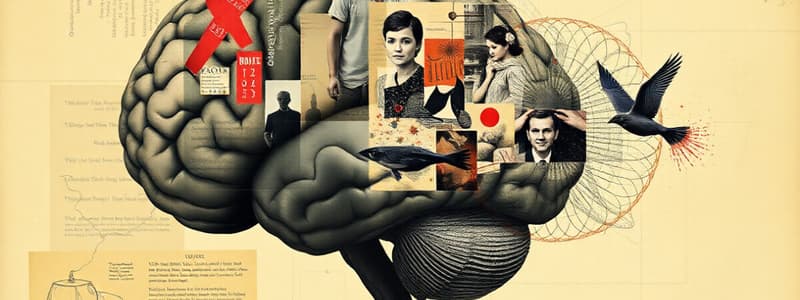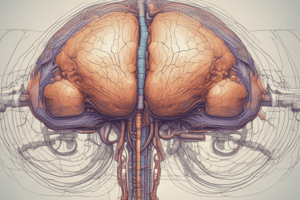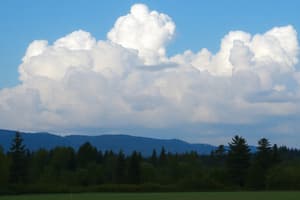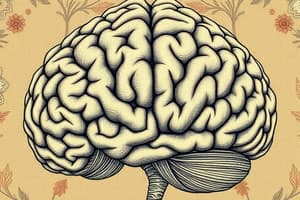Podcast
Questions and Answers
Given the cerebellar influence on both motor and cognitive functions, what might be a consequence of cerebellar damage beyond motor deficits?
Given the cerebellar influence on both motor and cognitive functions, what might be a consequence of cerebellar damage beyond motor deficits?
- Loss of olfactory discrimination, affecting the ability to distinguish smells.
- Impaired executive functions such as planning and decision-making. (correct)
- Visual processing deficits, leading to difficulties in object recognition.
- Reduction in auditory acuity, making it hard to discern subtle differences in sound.
A researcher is studying the effects of targeted cerebellar lesions in primates. If they observe deficits in visually guided movements after lesioning a specific area, which region of the cerebellum is MOST likely affected?
A researcher is studying the effects of targeted cerebellar lesions in primates. If they observe deficits in visually guided movements after lesioning a specific area, which region of the cerebellum is MOST likely affected?
- The cerebrocerebellum, given its connections with the premotor cortex. (correct)
- The vestibulocerebellum, due to its role in balance and eye movements.
- The spinocerebellum, due to its direct input from the spinal cord regarding proprioception.
- The fastigial nucleus, due to its involvement in axial muscle control.
A patient exhibits impaired coordination and postural instability after a stroke. Imaging reveals damage primarily to the flocculonodular lobe of the cerebellum. Which specific function is MOST likely affected?
A patient exhibits impaired coordination and postural instability after a stroke. Imaging reveals damage primarily to the flocculonodular lobe of the cerebellum. Which specific function is MOST likely affected?
- Integration of proprioceptive information for smooth movements.
- Maintenance of balance and vestibulo-ocular reflex (VOR). (correct)
- Fine motor control of distal limb movements.
- Planning and sequencing complex motor tasks.
An individual is learning to play a new musical instrument. Initially, their movements are jerky and uncoordinated, but with practice, they become smoother and more precise. Which cerebellar mechanism is MOST directly involved in this motor learning process?
An individual is learning to play a new musical instrument. Initially, their movements are jerky and uncoordinated, but with practice, they become smoother and more precise. Which cerebellar mechanism is MOST directly involved in this motor learning process?
In a study examining cerebellar function, researchers use transcranial magnetic stimulation (TMS) to temporarily disrupt activity in a specific cerebellar region. If TMS over this region leads to deficits in adjusting movements to compensate for unexpected external forces, which area is MOST likely being targeted?
In a study examining cerebellar function, researchers use transcranial magnetic stimulation (TMS) to temporarily disrupt activity in a specific cerebellar region. If TMS over this region leads to deficits in adjusting movements to compensate for unexpected external forces, which area is MOST likely being targeted?
A neurologist is assessing a patient with a suspected cerebellar lesion. The patient can initiate movements but struggles with the accuracy and smoothness of reaching tasks, displaying signs of dysmetria. Which cerebellar pathway is MOST likely compromised?
A neurologist is assessing a patient with a suspected cerebellar lesion. The patient can initiate movements but struggles with the accuracy and smoothness of reaching tasks, displaying signs of dysmetria. Which cerebellar pathway is MOST likely compromised?
During a research experiment, a subject is asked to perform rapid, alternating movements with their hands. If they exhibit difficulty maintaining a consistent rhythm and amplitude, displaying irregularities known as dysdiadochokinesia, which cerebellar region is MOST likely involved in this deficit?
During a research experiment, a subject is asked to perform rapid, alternating movements with their hands. If they exhibit difficulty maintaining a consistent rhythm and amplitude, displaying irregularities known as dysdiadochokinesia, which cerebellar region is MOST likely involved in this deficit?
A physical therapist is working with a patient who has cerebellar damage. The patient presents with an intention tremor that worsens as they reach toward a target. Which strategy would MOST effectively help the patient improve their motor control during functional tasks?
A physical therapist is working with a patient who has cerebellar damage. The patient presents with an intention tremor that worsens as they reach toward a target. Which strategy would MOST effectively help the patient improve their motor control during functional tasks?
A researcher is investigating the role of different cerebellar pathways in motor adaptation. They use a lesion paradigm to disrupt specific cerebellar structures. Disruption of which structure would MOST likely impair the ability to adapt to visual distortions, such as those experienced when wearing prism goggles?
A researcher is investigating the role of different cerebellar pathways in motor adaptation. They use a lesion paradigm to disrupt specific cerebellar structures. Disruption of which structure would MOST likely impair the ability to adapt to visual distortions, such as those experienced when wearing prism goggles?
Considering the cerebellar circuitry, which statement BEST captures the functional interaction between mossy fibers, granule cells, and Purkinje cells in motor coordination?
Considering the cerebellar circuitry, which statement BEST captures the functional interaction between mossy fibers, granule cells, and Purkinje cells in motor coordination?
Flashcards
Cerebellum Size and Neurons
Cerebellum Size and Neurons
Occupies 10% of brain volume, but contains 50% of the neurons.
Cerebellum Function
Cerebellum Function
Influences movement coordination and postural control by comparing intended movement with actual movement and adjusting as needed.
High fidelity tracts
High fidelity tracts
Tracts carrying unconscious proprioception from receptors in muscles, tendons, and joints.
Internal feedback tracts
Internal feedback tracts
Signup and view all the flashcards
Cerebellum Structure
Cerebellum Structure
Signup and view all the flashcards
Vestibulocerebellum
Vestibulocerebellum
Signup and view all the flashcards
Spinocerebellum
Spinocerebellum
Signup and view all the flashcards
Cerebrocerebellum
Cerebrocerebellum
Signup and view all the flashcards
Mossy Fibers
Mossy Fibers
Signup and view all the flashcards
Climbing Fibers
Climbing Fibers
Signup and view all the flashcards
Study Notes
- Cerebellum influences coordination of movement and postural control
- It compares intended movement with actual movement, adjusting as necessary
Cerebellum Composition
- Occupies 10% of the total brain volume (TBV)
- Contains 50% of the brain's neurons
- Receives wide variety of inputs
- Maintains a similar basic structure internally
Cerebellum Inputs
- From the spinal cord: includes proprioception and information of spinal cord activity
- M1/PMA is efferent copy
- Premotor area: Visually guided movements
- Prefrontal cortex
- Parietal cortex
Spinal Cord Input
- Cuneocerebellar tracts: Proprioception from arms and upper trunk
- Posterior spinocerebellar tracts: Proprioception from legs and lower trunk
- Anterior spinocerebellar tracts: Thoracolumbar spinal cord activity, involved in gait cycle (SPG/CPGs)
- Rostrospinocerebellar tracts: Cervical cord activity
High Fidelity Tracts
- Carry information for unconscious proprioception
- Relays signals from receptors in muscles, tendons, and joints
Internal Feedback Tracts
- Monitor the activity of spinal interneurons and of descending motor signals
- Signals originate from the cerebral cortex and brainstem
Key Corticol areas Involved
- Primary motor cortex (M1)
- Premotor cortex
- Supplementary motor area
- Dorsal spinocerebellar tract
- Ventral spinocerebellar tract
Functional Divisions
- Outer layer of grey matter and inner white matter
- Has Deep Cerebellar Nuclei (DCN)
- DCN are the output of Cerebellum, names after inputs
Vestibulocerebellum
- Vestibular nuclei, (not within cerebellum)
- Receives input from vestibular apparatus
- Sends output for balance and equilibrium
- Influences brainstem descending tracts and vestibulospinal functions incl medial/lateral
Spinocerebellum
- Fastigial nuclei & Interposed Nuclei
- Receives somatosensory, visual, auditory, and vestibular information
- Vermis section - Influences medial motor tracts (VST, RST, Medial CST), equilibrium
- Paravermal section - Influences LCST, rubrospinal, reticulospinal
Cerebrocerebellum
- Dentate Nuclei
- Receives input from the cerebral cortex
- Sends output to influence LCST and corticobrainstem tracts
- Output is to Cerebral Cortex
Points to Note
- The cerebellum has no direct connections with motor neurons "Influencer" specialized according to Input. Targets its output Table 15.2 in Lundy-Ekman
Cerebellum Layers
- Cortex with 3 Grey matter Layers
- Outer Molecular layer
- Middle Purkinje cell layer (output)
- Inner Granule cell layer
- 2 Input Neurons
- Mossy fibers
- Climbing fibers
Outputs
- Purkinje cells are inhibitory
- One output neuron (inhibitory)
- Connecting granule cell/parallel fibers
Mossy Fibers
- Provides proprioceptive input/internal feedback from spinal cord
- Runs efferent information from MI/PMA
- Provides vestibular information
- Synapse onto the granule cells
- The granule cells then synapse onto purkinje cells
Climbing Fibers
- Originate in the inferior olive
- Inferior olive receives spino-olivary tract information
- Synapse directly onto purkinje cells
- Has one climbing fiber to each purkinje cell
Granule Cells Role
- Mossy fibers excite them
- Axons go up to the molecular layer
- They bifurcate and become the parallel fibers
- Each parallel fibre synapses with tens, if not thousands, of purkinje cells
Cerebellar Circuitry loops
- Excitatory: + DCN, where updated sensory information is relayed
- Inhibitory: + granule, + Purkinje, - DCN, Allowing updating
- Mossy fibers support constant updating/sculpting/shaping
Role of Climbing Fibers
- Powerfully excite purkinje cells
- Are only active when there is a problem with movement
- Transmit an error signal allowing tell's it NO!
Error Detection
- The resetting mechanism provides adaptations that are needed and when motor learning is in progress
- Cerebellar circuitry allows for error detection and correction
- Operates in both feedback and feedforward modes which are both important for motor learning
- The cerebellum is only active when there is a problem with movement
- Transmit an error signal allowing resetting signals in the brain
Studying That Suits You
Use AI to generate personalized quizzes and flashcards to suit your learning preferences.




